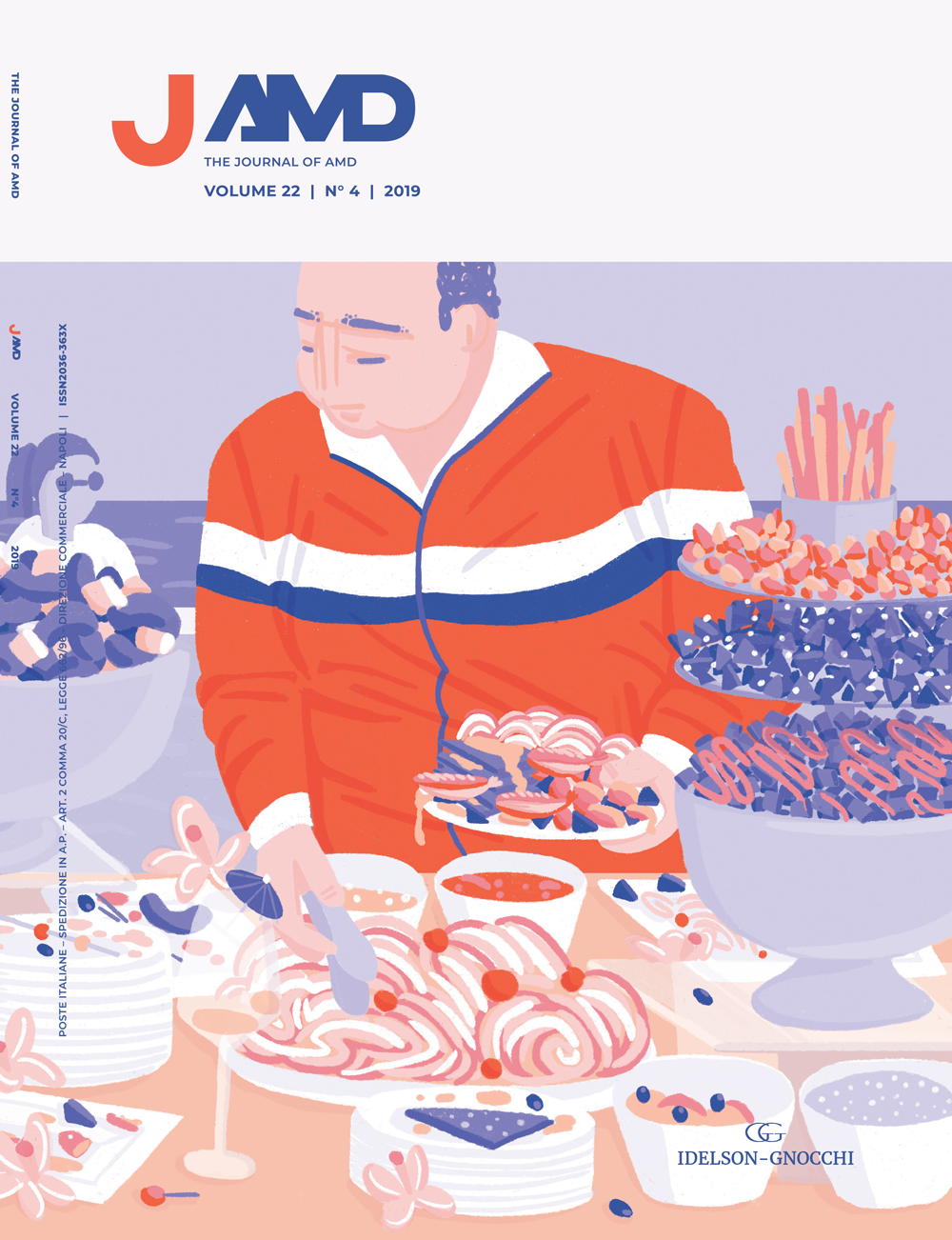Editorial
All you can eat (and drink)
JAMD 2019;22(4):176-177
Research article
Natural history and risk factors for diabetic nephropathy in Italy: insights from AMD Annals initiative
JAMD 2019;22(4):178-184
Diabetic patients have a high risk to develop diabetic nephropathy. Diabetic nephropathy represents non only a risk factor for progression toward end stage renal disease but it is also associates with an increased risk to have of major cardiovascular events. Over the last few years, analysis of the AMD annals dataset has contributed several important insights on the clinical features of type 2 diabetes kidney disease and their prognostic and therapeutic implications. First, non-albuminuric renal impairment is the predominant clinical phenotype. Even though associated with a lower risk of progression compared to overt albuminuria, it contributes significantly to the burden of end-stage renaldisease morbidity. Second, optimal blood pressure control provides significant but incomplete renal protection. It reduces albuminuria but there may be a J curve phenomenon with eGFR at very low blood pressure values. Third, hyperuricemia and diabetic hyperlipidemia, namely elevated triglycerides and low HDL cholesterol, are strong independent predictorsof chronic kidney disease onset in diabetes, although the pathogenetic mechanisms underlying these associationsremain uncertain. These data help clarify the natural history of CKD in patients with type 2 diabetes and provide important clues for designing futureinterventional studies.
KEYWORDS albuminuria; glomerular filtration rate; hypertension; uric acid; type2 diabetes mellitus.
Transferability of CVOTs EMPA-REG OUTCOME and LEADER in the real world in Italy
JAMD 2019;22(4):185-196
Cardiovascular disease is the leading cause of morbidity and mortality among people with diabetes (DM). Fortunately, data from cardiovascular outcome trials (CVOT) and scientific research have provided the diabetologist with very effective weapons (SGLT2i; GLP-RA) to combat cardiovascular diseases in patients with diabetes. However, the potential of the new molecules is not exploited by Italian diabetologists appropriately. The dimensions of this “underuse” and the reasons that support it are not clear. The AMD Annals initiative can provide important information in this regard, thanks to the availability of a large clinical database that is largely representative of the Italian diabetologist clinical practice. In this study data from AMD Annals database were used to quantify the proportion of patients potentially eligible for the EMPA-REG and LEADER studies, the percentages of patients currently on medication with SGLT2i or GLP1 RA, and the potential impact resulting from the use of these treatments in all eligible patients. Mann-Whitney U test or chi-square test were used to compare socio-demographic and clinical characteristics of the patients potentially eligible for the two trials were compared with those of patients who did not meet the eligibility criteria. Reductions in the absolute risk of cardiovascular death and hospitalization for heart failure or myocardial infarction associated with the use of the drugs if all eligible patients had been treated, were estimated on the basis of the rates shown in the EMPA-REG OUTCOME and LEADER trials. From the analysis of the data it is evident that many subjects with type 2 diabetes afferent to diabetological structures could benefit from treatments that in clinical trials have documented positive effects on cardiovascular events. Unfortunately, however, only a minimal proportion of these patients is actually in treatment, while a widespread use of these molecules would lead to avoiding a substantial number of deaths, myocardial infarcts and hosptalization for heart failure every year. It is to be hoped that in the near future the appropriate use of SGLT2i and GLP1 RA, in accordance with the most recent Italian and international guidelines, can be extended to all patients who can benefit from it, thus contributing to reducing the clinical, social impact and economic cardiovascular disease among people with T2DM.
KEYWORDS SGLT2 inibithors; GLP1 receptors agonists; cardiovascular events, CVOT.
Type 2 diabetes therapy’s quality based on gender. Monographs of AMD Annals 2018
JAMD 2019;22(4):197-209
OBJECTIVE OF THE STUDY Evaluate the evolution of the therapy’s quality by gender in type 2 diabetes (DM2) in Italy, from 2011 to 2016, considering the new AMD Indicators in a gender perspective and the possible disparity in the drug treatment.
DESIGN AND METHODS For the purpose of this analysis, data from the AMD Annals 2018 were used. They refer to patients with DM2, treated in
2016 in 222 diabetology services. This report is based on the analysis of the new 2015 AMD indicators (Audit 2, January 23rd, 2018). The characteristics of the study population and the analysis of the indicators are reported separately for men and women affected by DM2.
RESULTS The data of 242,422 men and 184,696 women with DM2 were evaluated. The patients were treated by 222 diabetology services in 2016. The distribution by gender shows the prevalence of males and the one by age shows a general aging of the population and an increased survival, mainly in women (3.6% of men and 6.6% of women with DM2 have an age >85 years). The average number of visits per treatment group was comparable between sexes. Compared to the 2011 evaluation, an improvement was achieved in all the process indicators in both genders, although still slightly better in males. In particular, the evaluation of metabolic control through the monitoring of glycated hemoglobin affects almost all male and female patients (96.9% vs 97%).
The percentage of patients monitored for lipid profile, renal function, retinopathy and foot screening is lower. Some parameters were considered intermediate outcome indicators as they predict cardiovascular (CV) risk: the achievement of targets for the main CV risk factors is systematically unfavorable for women with DM2. In particular, women are more obese, have a worse diabetes compensation (especially a worse lipid profile) and a greater frequency of glomerularfiltrate reduction. The average levels of glycosylated hemoglobin were slightly higher in women than in men (7,3% ± 1,3 vs 7,2% ± 1,2), also the average levels of LDL cholesterol (100,2 mg/dl ± 33,4 vs 92,5 mg/dl ± 32,3) and average BMI levels (30,1 kg/m2 ± 6.1 vs 29,2 kg / m2 ± 4,9). In comparison with 2011 data, is noticeable a slight reduction in smokers among males and a slight increase among women (20,5% vs 21,5% in men, 12,2% vs 11,8% in women). Overall, the quality of the therapy (assessed with Q score) has improved over the years, in a similar way for both sexes. About half of the patients, in both sexes, have a Q score >25, therefore adequate levels of therapy. The use of drugs for the control of glycaemia in both genders is similar also for innovative drugs. The use of statins is high in both sexes, slightly in favor of women. The intensity of the therapy for hypertension has improved in both sexes. Hence, the available data does not highlight a problem of under-treatment of women, despite their worst results. Gender data related to micro and macroangiopathic complications show differences in the two sexes, but the quality of the data recording on final outcomes, especially cardiovascular, is still modest.
CONCLUSIONS Data analysis shows a significant improvement in the quality of specialistic health care, with greater attention in monitoring CV risk factors and complications, an increase in the percentage of subjects in target and a more intensive use of drugs in both sexes. However, some gaps are still present. The examined data confirm that the cardiovascular risk profile is decidedly unfavorable for women and that the main cardiovascular risk factors control, although improved over the years, remains sub-optimal in women and men. Greater efforts are needed to optimize CV risk factors management in both sexes and to reduce, or better eliminate, differences between genders. These data offer important insights for research, clinical practice and review of guidelines in a gender perspective, taking into account that various factors related to gender, such as genetic/biological aspects, lifestyle, adherence to therapies, psycho-social aspects, in addition to prescriptive differences, can affect the achievement of the various outcomes.
KEYWORDS gender; DM2; AMD indicators.
Therapeutic inertia of the Diabetologist: from the clinical algorithm to the mental algorithm. DIADEMA-AMD project
JAMD 2019;22(4):210-218
Several type 2 diabetic patients never reach the recommended metabolic goals because the proper therapy is not prescribed or modified. The problem is known as “therapeutic inertia.” In the literature, there is a wide range of available methodologies suited to analyze the problem. Almost in all instances, however, this problem is attributed to external factors – organizational issues, time constraints, financial restrictions and patient resistance – while the diabetologist’s mental process, well-being and emotions are often ignored. Acknowledging the issue is the first step to overcome the impasse of therapeutic inertia. Often diabetologists lack self-awareness of their own mistakes. The goal of the Diadema project is to analyze and understand the processes that are responsible for the actions and facilitate a real change.
KEYWORDS therapeutic inertia; emotions; change; communication; relationship; awareness
Heart failure in patients with diabetes in Campania
JAMD 2019;22(4):219-229
Heart Failure (HF) and Type 2 Diabetes Mellitus (T2D) are important clinical conditions that often coexist, mutually influencing intra- and extra-hospital morbidity and mortality. In order to characterize the diagnostic and therapeutic management of patients with HF and T2D, a retrospective observational study was conducted on database of the last 12 months in 8 Campania Diabetology Centers. 164 patients were affected by HF and T2D. Among them, 123 patients had a medical record with reproducible data and were recruited for the study. Diabetic patients were divided into three groups: group A included patients with preserved ejection fraction (EF) (> 50 %), group B patients with midrange EF (40-49%) and the group C patients with reduced EF (< 40%). All patients had performed ECG and echocardiography, repeated every 6 months; 41 patients (33% of the sample) also performed a cardiac Holter. The most frequent causes of HF were ischemic heart disease and hypertension. After a 12 months follow up, the clinical and laboratory parameters and the treatments adopted were re-evaluated. The antidiabetic drugs resulted modified with a reduction in the use of metformin, sulfonylureas, glinids and pioglitazone; at the same time a greater use of gliptins, gliflozines and GLP1 AR and a lower use of insulin therapy was observed. Cardiological therapy was modified with a greater use of diuretics and nitrates and a reduction of ACEI and ARB, probably due to the use of sacubitril/valsartan association in the group of patients with reduced EF. According to the recent guidelines, antidiabetic therapy must be tailored to the characteristics of the patients with diabetes and heart failure, preferring the use of molecules that have shown a cardiovascular protection effect or, secondarily, those with cardiovascular neutrality. Similarly, cardiological therapies have to consider the type of antidiabetic agents used and benefit from molecules that impact clinical symptoms and natural history. Finally, the approach to the patients with both the pathologies must necessarily take place in the healthcare districts and absolutely be multidisciplinary and integrated, involving firstly Diabetologists and Cardiologists, but also other professional roles (nurses, psychologists, physiotherapists, caregivers) operating in the territorial healthcare services.
KEYWORDS diabetes mellitus; heart failure; ejection fraction.
Case reports
Use of autologous peripheral blood mononuclear cells in a case of diabetic foot
JAMD 2019;22(4):230-233
The implantation of peripheral blood mononuclear cells (PBMNC), an autologous concentrate with high angiogenic and regenerative capability is an innovative therapeutic approach in the treatment of peripheral arteriopathies of patients with critical limb ischemia. We describe the case of a 59-year-old patient with type 2 diabetes mellitus who had a gangrene of the right toe. The critical limb ischemia required an angioplasty that was ineffective due to the widespread, obstructive, intractable and calcific disease of the distal tibial vessels and of the foot vessels. Because of the therapeutic failure, being the patient otherwise candidated for major amputation, it was decided to use a PBMNC therapy. This approach consists in the inoculation in the perilesional area and along the vascular axes of the affected lower limb of a concentrate of mononuclear cells taken from peripheral blood by using a selective filtration separation system. The patient underwent to amputation of the first necrotic toe and three PBMNC treatment sessions with complete surgical wound haeling and limb rescue.
KEYWORDS diabetes mellitus; critical limb ischemia; mononuclear cells therapy.
Documento congiunto AIMN AMD AIOM
Management of blood glucose levels in oncological patients scheduled for FDG PET/CT examination
JAMD 2019;22(4):234-237
Simposio – Dissipandum non est: avanzi, scarti, sprechi
Daily waste
JAMD 2019;22(4):238-241
In the early 20th century, in the rural economy of Italy, the idea of wasting food was unheard of, and about 50% of income was spent providing food. Today food only involves 10% of average income, but we have forgot how to deal with what we eat.
Consumerism, which also affects our behavior towards food, is a cultural attitude based on which people feel more or less realized solely on the basis of their purchasing possibilities.
If we separate food from necessity, health, needs of everyone; we separate the production from the times of the seasons, from nature and from the possibilities that the land has to regenerate its resources; if we separate the act of eating from that of knowing what we eat; if all the phases of the production chain lose the connection between them, then the waste is not only inevitable, but even pursued because it is functional to the criterion of maximum profit. A lesser evil to the detriment of our planet, which leads us to a further waste: a waste of health. We therefore need a change of pace that concerns regulations, energy choices, basic culture, ecology education; we also need profound changes in the value scales, in individual and collective behavior. We must return to considering family, traditional and small-scale agriculture, with its integrated systems and its productive capacities commensurate with the needs of communities and natural resources, as a driving force on which to base the change towards a relationship with food that meets our needs without compromising those of other living beings, current and future.
KEYWORDS food; waste; consumerism; environment; health.
From “Fridays for future” to ecological and circular economy in our houses
JAMD 2019;22(4):242-244
Waste in Health Care
JAMD 2019;22(4):245-253
Waste in a health service is every activity, behavior, asset and service that, using resources, does not produce results in terms of health, well-being or quality of life. According to the OECD, in different countries, about 20% of health expenditure makes little or no contribution to improving people’s health. Avoiding waste is theoretically easy: health interventions delivered according to a principle of appropriateness are not wasting. However, there are multiple obstacles. Waste has, in fact, different causes: inappropriateness, use of ineffective health interventions, over- and under- use of health interventions, low quality standards, medical errors, lack of innovation, misplaced and unmotivated resource allocation, administrative complexity, incorrect management of equipments, assets and services, wasted time, non-compliance with quality standards, purchasing of technologies and assets at an excessive price, incomplete design or non-completion of works, fraud and corruption. In Italy, in 2017, waste in Health Service, even if calculated on indirect and inaccurate data, was estimated at 21.59 (±20%: 17.27 – 25.91) billion euros, 17-21% of public health spending. Strategies to reduce waste are essentially two: stop doing activities that do not generate value; use, if any, equal in effectiveness and safety, but less expensive, alternatives. The implementation goes through targeted research and the culture of continuous improvement rooted in the organization and owned and applied by decision makers and every health or administrative provider.
KEYWORDS health resources; allocation of resources; cost-benefit analysis; health services misuse; inappropriate prescribing.
How not to waste: appropriateness in medicine
JAMD 2019;22(4):254-261
The idea that the author promotes is that the term waste amounts to inappropriateness whatever the economic environment referred to. The hope is that it can act as a prod for those people who wish to make more rational and economically more convenient work choices by reducing the opportunities for conflict, the loss of time, the legal disputes, the bottlenecks, the incompetence. Two possible approaches to waste are presented. The first represents the point of view of the industry, it is only apparently distant. Thought, the lean organization requires an effort of reading and perhaps greater analysis but, mutatis mutandis, the areas of waste, that is of inappropriateness, are perfectly adaptable to the health world. The second was born in the health world, originates from a work of an important author in the world of quality in medicine, identifies six categories of waste and was taken up in our country by the GIMBE Foundation, giving inspiration or a strong debate. Reflection on each category allows the expert physician to translate his content into his everyday life and draw hypotheses and stimuli for a possible change in clinical organizational practice, in a vision of contrasting inappropriateness. Homo medicus continually needs to be solicited and have elements of reflection to make choices that minimize, in this case, the behavior of inappropriateness (waste) prescriptive and organizational.
KEYWORDS waste; appropriateness; lean production.
Le news di AMD
Newsletter Annali AMD n. 27
AMD Annals Newsletter n. 27
JAMD 2019;22(4):268-269
Newsletter Rete di Ricerca n. 41
AMD Research Network Newsletter n. 41
JAMD 2019;22(4):270-272




